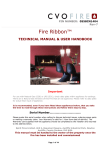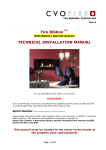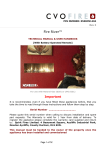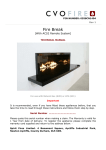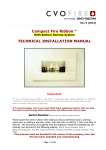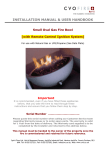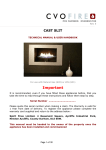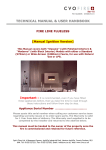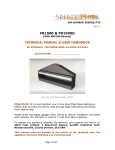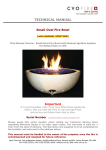Download Black Box AC096A Technical data
Transcript
PIN NUMBER: 0558CN1404 Rev 10 Fire River™ TECHNICAL MANUAL & USER HANDBOOK For use with Natural Gas (G20) or LPG (G31) Important It is recommended, even if you have fitted these appliances before, that you take the time to read through these instructions and follow them step by step. Serial Number ……………………………… Please quote this serial number when making a claim. The Warranty is valid for 1 Year from date of delivery. To register the appliance please complete the warranty card supplied and return to the address below: Spirit Fires Limited. 4 Beaumont Square, Aycliffe Industrial Park, Newton Aycliffe, County Durham, DL5 6XN. This manual must be handed to the owner of the property once the appliance has been installed and commissioned Page 1 of 44 Contents Page Page Page Page Page Page Page Page Page Page Page Page Page Page Page Page Page Page Page Page Page Page Page Page Page Page Page 3 4 5 6 7 8 10 12 13 15 16 18 18 19 20 21 22 23 24 25 27 28 29 30 31 31 33 Commissioning Certificate Technical Data Introduction Unpacking the Appliance Power Supply Component List Burner Construction Remote Control System General Installation Instructions Installation & Building Instructions Fitting the Enclosure Fitting the Optional Fascia Burner Unit Magic Eye Position Commissioning the Fire Oxygen Depletion Pilot System Reset the Appliance Fault Finding & Troubleshooting The Remote Control Box Pilot Assembly/Spark Failure Remote Wiring Diagram with SIT Pilot Remote Wiring Diagram with Seagas Pilot Exchangeable Components List Servicing Instructions Service and Aftercare Requirements Warning: Fire Guards & Hearths USER HANDBOOK Page 2 of 44 CVO Commissioning Checklist Important Notice Explain the operation of the appliance to the end user, hand the completed instructions to them for safe keeping, as the information will be required when making any guaranteed claims. Pass Fail Flue Check 1. Flue is correct size and length for the appliance 2. Flue Flow test 3. Spillage test Gas Check 1. Gas soundness & let by test 2. Standing pressure test 3. Appliance working pressure (on High Setting) NB All other gas appliances within the property must be operating on full rate. 4. Gas rate test 5. Does ventilation meet appliance requirements Dealer and Installer Information Dealer……………………………………………… Installation Company……………………… ………………………………………………………… ………………………………………………………… ………………………………………………………… ………………………………………………………… Contact No……………………………………… Engineer………………………………………… Date of Purchase…………………………… Contact No……………………………………… Model No………………………………………… Corgi Reg No…………………………………… Gas Type………………………………………… Date of Installation………………………… This product is guaranteed for 1 year from the date of installation, as set out in the terms and conditions of sale between CVO and your local CVO dealer. This guarantee will be invalid, to the extent permitted by law, if the above Commissioning Checklist is not fully completed by the installer. Page 3 of 44 Page 4 of 44 Introduction This appliance is supplied as a complete suite of enclosure of gas fire burner unit, enclosure and fascia. To comply with the approval this fire must be installed as designed. The fascia must be installed as intended and ventilation to the burner must be provided. Special notice should be taken for the requirements of both the metal and stone fascia versions as the enclosure must be installed differently. An optional gather is available upon request to attach the enclosure to a 200mm Flue Liner. This should be ordered with the appliance however if this has been missed this can be ordered from Customer Services on 01325327221. Depending on the stock situation this may take a number of days. This is a high power appliance and a steady gas supply within +/- 1mBar of the approved pressure must be maintained at all times. Inlet is via an 8mm gas line. If the gas line is longer than 1.5mtrs then the gas line should be increased in diameter to 15mm and possibly larger depending on the length of gas pipe required. LPG Version. If running n Gas Bottles two 47Kg bottles with regulator and changeover valve will be required. Failure to do this will result in nuisance shutdowns. This appliance requires a 240v 3A fused spur next to the appliance and within easy access of the user. Page 5 of 44 Unpacking the Appliance Read these instructions fully before proceeding. Carefully examine the carton for damage before unpacking. If it is obviously damaged, consult the supplier over whether to proceed. Remove the fire and examine its general condition. Any damage or defects must be reported “before” installing the appliance. No claims will be accepted for damage after the appliance has been installed. If satisfied by the condition proceed with the installation. The installation should only be carried out by a CORGI Registered fitter and in accordance with national and local Regulations for both gas and electricity. The installation must also be in accordance with relevant parts of local and national building regulations. For the Republic of Ireland, reference should be made to IS813 and ICP3 and any guidance notes from Bord Gais. Failure to have the fire fitted by a qualified person nullifies ALL guarantees. Page 6 of 44 Power Supply Read through this section before starting the installation The installation should only be carried out by a CORGI registered installer and in accordance with national and local regulations for both gas and electricity. Power Supply 230v AC-15%+10%, 50/60 Hz Max power consumption 20VA cos 0.6 (Peak) Stand-by power consumption 1W Ambient Temperature 0.80 C Protection IP 20 Humidity Max 95% at 40c Electrical protection Not required Connections STELVIO/STOCKO Waiting time for demand 3-5 seconds typically Ignition Time 20 seconds typically Ignition Frequency 1Hz Spark gap Max 6mm Ignition Cable length 500mm The black lead is the electrical feed to the burner, a 3 amp fused spur located wherever convenient is to be connected between the power supply and the burners black lead. The Grey or white wire is connected to the hardwire switch which if used, can be positioned as required. NOTE- DO NOT connect the Hardwire switch to the mains, as this will damage the unit. A mains connection is required close to the fireplace-a 0.7m cable is provided for this purpose with a special plug connected to the burner control box. A 3amp socket may be used, or a fused spur outlet can be purpose provided. The colour code of the mains is as follows; Green/Yellow - EARTH Brown - LIVE Blue - NEUTRAL The appliance must be in a position so that the mains supply is accessible for routine maintenance. A 3amp fused should be fitted in the plug of fused spur. WARNING – This appliance must be earthed. Page 7 of 44 Component List Specification Page 8 of 44 Page 9 of 44 Burner Construction Take some time to review the burner construction taking note of the positions of the main components and connections. WARNING: Removal of the connections from the remote system or the grommets marked “Electric Supply” or “Hard Wire switch lead” as shown in the burner construction drawings will result in the warranty being invalidated. No claims will be accepted for damage caused by the burner being tampered with. All CVO fires are given a 100% full function test at the factory and are very reliable hence there is no need to remove any fittings. Before commencing to create the fire opening for the inglenook unit, Note to maintain a good standing pressure we recommend that a 15mm supply be piped in as close as possible with a reduction down to 8mm diameter copper pipe (no longer that 2m in length – gas supply to the burner unit) must be installed, the gas supply pipe should run into the installed enclosure from either the rear, left or right hand sides, the gas supply is best run through the left side of the enclosure. Additionally a 240volt 3amp fused spur power supply should be installed. This is best fitted so that the power supply is located to the right side of the unit. This will provide the power source for the remote control system. NOTE – DO NOT connect power to the hardwired switch as this will damage the remote control system. There are yellow labels attached to the cables please follow the information. Burner Removal Removal of the burner will invalidate the warranty. If the burner needs to be removed for repair follow the below steps: • • • • • • Remove the front shelf. Remove the 2 screws on each side which hold the shelf mounting brackets to the enclosure. Disconnect the gas and electricity supply. The burner carriage is screwed to the bottom of the enclosure by 2 screws. Once removed the full burner assembly will lift out. Refit is the same procedure in reverse. The fire should be commissioned once refitted. Page 10 of 44 LPG Version Natural Gas Version Page 11 of 44 Remote Control System The remote system is supplied with both the hard-wired wall mounted switch and infrared hand held system as standard. Both options allow full control of the fire – ON, OFF, UP, DOWN. The wall mounted switch and cable carries low voltage, (20v). The colour code used in the switch wiring diagrams must not be confused with normal mains colour coding. Use and install both systems. This gives increased reliability and is recommended by CVO. The removal of the remote components can lead to accidental damage of the remote system which will not be covered by the warranty. The magic eye is situated on the fascia and great care must be taken on plugging this into the control board. When running the cabling for the hardwire great care must be taken to ensure that the switch is wired correctly (see image below taking notice of the “top” of the switch which is where the Blue/Brown are attached. Page 12 of 44 General Installation Instructions This Fire River unit is intended for decorative purposes. The installation must be in accordance with National Regulations and must be carried out by a qualified installer. Clearances between the fire and all combustible materials must conform to National Regulations. This fire must be installed and used in accordance with these instructions. Prior to installation, ensure that the local distribution conditions (identification of the type of gas and pressure and the adjustment of the appliance) are compatible. The builders opening or fireplace opening must be constructed of a noncombustible material. When installed, this unit should be located to the rear of the fire opening. For some countries a purpose provided air supply must be fitted in accordance with National Regulations (e.g. United Kingdom - minimum 100 cm2) For some countries a non-combustible hearth must be fitted in front of the fire in accordance with National Regulations (e.g. United Kingdom). Any flue damper plate or flue restrictor must be removed or fixed permanently in a fully open position, or shall only be fitted in accordance with National Regulations. The chimney must be swept before the appliance is installed. NOTE: If the chimney is not swept, there is a possibility that loose debris will fall onto the appliance which may result in damage and unnecessary service costs. A simple smoke test will determine if the flue is working correctly. Before the fire is installed a flue test in accordance with National Regulations should be carried out. The unit must not be installed unless the chimney / flue length is at least the length and size indicated in 54.1 ‘Technical Data’. Under no circumstances should this unit be installed and operated within any premises with an inadequate flue or chimney system. The gas connection must be in accordance with National Regulations. An isolation valve (or valves) has to be fitted adjacent to the appliance, which, when closed allows the complete burner and control assembly to be disconnected for maintenance and repair in accordance with national regulations. Page 13 of 44 The pilot light and flame sensing device fitted to this fire is also an atmosphere sensing device. If for any reason any part of the pilot assembly is to be replaced ALL the assembly including the pilot burner, thermocouple, electrode and injector must be exchanged complete for an original manufacturer's pilot assembly only. This atmosphere sensing device is not adjustable and must not be put out of action. The pilot light shuts off both the main burner and pilot if evacuation of the combustion products is interrupted. If the fire shuts itself off, do not use the fire, and have the flue and fire checked by a suitably qualified person. Do not throw rubbish on the unit, as this will block or hamper its efficiency. Due to the newness of the materials, the fire may give off a slight smell for a period of time after commissioning. This is quite normal and any odours should disperse within a few hours of operation. IMPORTANT NOTE: This fire is approved for use with a flue system of 1.5m. If a flue system in excess of the specified length is used this may cause a very strong draw to occur which will result in the flame being adversely effected. This may cause the flame to be forced down onto the back shelf and back of the enclosure. If this occurs additional air ventilation for the burner should be installed to ensure that air can flow into the burner tray and maintain the flame in the correct manner. This ventilation can be provided by: • If a trimless installation: o A ventilation grill at skirting level and appropriate ducting to allow air into the front of the burner tray. • If using optional trim: o Slots or Holes cut in the plasterboard on the bottom edge behind the trim. The trim is designed to have a small air gap all around. This must not be blocked. This small gap will allow air through the front into the burner tray. o Failure to ensure the correct flue requirements and burner ventilation will result in damage to the fire and enclosure which is not covered by the warranty. IMPORTANT NOTE: The enclosure has a number of additional holes which are to allow the most suitable routing of the gas pipe depending on where the property supply is routed to the opening. This allows the gas pipe to be from the left, right or back. Once the appropriate hole has been selected ALL the other holes MUST be sealed by using metal foil tape. Failure to do this may result in incorrect flame activity and burner damage. This is not covered by the Warranty. Page 14 of 44 Installation & Building Instructions Building and Installation Work A qualified person should complete all building work; a qualified and competent person to all relevant national legislative controls must carry out the installation of gas burners, mechanical extraction, flue systems and remote control units. Building work Building work should only commence after a thorough survey of the intended location of the impending installation has been completed and it has been established that the unit can be installed and operated without risk to the owner or tenants of the property or their neighbours. Where existing chimney River, they should have ensure that they are in adequate draw when the systems are to be used in conjunction with the Fire been swept and undergone thorough examination to a sound and safe condition, as well as providing an gas fire unit is in operation. A simple smoke test will reveal weather or not the chimney is working correctly. Installation Procedures It is important that the gas supply is disconnected before any old existing surround and hearth is removed. The Fire River enclosure should be located centrally to the existing flue / chimney at your desired height. If the fire is not placed central to the chimney, the flame picture may pull incorrectly. In some installations it is necessary to install a small lintel unit above the opening, if so an allowance must be made to accommodate the lintel. NOTE - The Fire River does not have its own support lintel. NOTE – The support lintel is not supplied with the unit. Warning - This Appliance must be Earthed Page 15 of 44 Fitting the Enclosure This fire is supplied with an enclosure and integral burner. IMPORTANT: The appliance is supplied with a fully tested and working gas burner. There is no need to dismantle the burner. This could result in damage to the fire which is not covered by the warranty. No connections should be removed or broken. Removal of any connections will result in the warranty being invalidated. The Fire requires 3 connections: 1. GAS SUPPLY. The fire has an 8mm inlet via an isolation valve. The fire also includes a pressure test point elbow to test inlet pressure. The gas pipe work should be routed into the enclosure via the available access holes. If the gas pipe work is over 1.5mtrs in length it is recommended that the pipe work is increased in diameter from this point to 15mm and possibly 22mm depending on the length to the meter. This will ensure a stable gas supply. 2. HARD WIRE REMOTE. The hard wire remote has a switch connected. This cable should be routed from the appliance to a position which is suitable for the user. If it is required to remove the switch plate in order to install into the wall great care must be taken when removing the switch. The switch has a “top” marked on it. The cables must be fitted back in the same sequence otherwise remote damage will occur. 3. MAINS VOLTAGE This is via a black cable. This must be fitted to a 3A 240V fused spur supply which is within access of the user should the fuse need changing. This is the power source for the remote control system. Great care must be taken when handling the burner and hard wire system. If using with the optional Gather, dry fit the gather to the enclosure taking note of where the gather and enclosure overlap. In some installations it may be possible to insert the gather into the opening and lift up to allow space to slide the enclosure in. This reduces the need for a very large builders opening. Page 16 of 44 The original fire opening must be closed, using bricks / blocks infill the opening to the required base of the burner, the void behind the brickwork should also be filled; block work or rubble can be used. (It is advisable to install a solid base inside the fire opening to sit the steel framework to). Builders Opening Height – 1000mm Width 965mm Depth – 450mm – The height is to be reduced once the unit has been fitted. It is best to dry fit the Fire unit first to ensure clarity this can ensure a clear route for gas and electrics. Note: The front edge of the enclosure must be positioned to be level with the “finished” edge of the wall making allowance for plaster board and any finishing. The enclosure must be secured to the block work to ensure it cannot move. The burner must be secure within the enclosure. Once the enclosure is fixed in a position, the gather (if required) can be fitted. Note: If the standard gather is not used, the flue must be connected to the enclosure in accordance with GAS SAFE and local regulation. Once the gather has been lined up with the enclosure it must be sealed to the enclosure by the use of silicone sealer or metal tape to ensure an airtight seal when fitting the gather. Screw the gather in place from the inside of the enclosure using the 6 countersunk screws provided. The gas, electric supply and hard wire switch should now be installed as instructed. IMPORTANT: If the burner is dismantled or any connections removed from the remote system the warrant will be invalidated. The fire is full tested at the factory prior to shipping. Page 17 of 44 The magic eye should now be installed as shown on page 19 Once all connections are made the burner should be tested for safe operation and gas leaks. For instruction on how to light the fire see the user section on page 25 Once tested the front shelf vanity cover should be fitted taking care not to scratch the enclosure. Fitting the Optional Fascia If using with the optional fascia, fit the fascia to the fire before rendering the wall around to ensure it fits. When rendering the wall up to the lower edge of the front shelf leave a 10mm gap to allow the bottom tabs on the fascia to locate with the underside of the front brackets on either side of the shelf. Attach the fascia to the enclosure using the 5 countersunk screws provided. Burner Unit Note: The design has been changed with the burner carriage being fitted within the complete enclosure this is to make installation easier. The images on the next page show the carriage within the “old style” burner tray. Note: The burner carriage can be taken out if required by removing the screws securing the left and right front shelf brackets and removing the screws which hold the carriage into the enclosure. Page 18 of 44 Magic Eye Position Page 19 of 44 Commissioning the Fire This appliance requires a specific amount of ventilation to function as designed (correct flame picture), therefore any unused utility access points in the burner tray must be sealed with Aluminium foil tape. When installing the enclosure into an existing chimney with a flue liner the enclosure & gather must be sealed to the existing chimney to ensure that air cannot flow behind the enclosure. Failure to do this will result in serious damage to the burner unit and enclosure. This damage is not covered by the warranty. TEST THE GAS PRESSURE. Turn the fire on full; attach a manometer to the inlet test point and ensure there is a pressure of 20mbar (+/- 1mbar) for natural gas appliances or 37mb for propane appliances. Now turn on all the other gas appliances in the house and re check pressure. The pressure must still be in the tolerance of +/- 1mb. Now turn off all the other gas appliances and turn the fire down to pilot only, the pressure must still be in the tolerance of +/- 1mbar. If it is not, TRANSCO, BORD GAIS or the propane supplier must be called to adjust the governor to the house before the fire can be commissioned further. For propane appliances, in order for the fire to operate consistently at least 2 x 47Kg bottles must be used with a changeover valve to maintain the inlet pressure at 37mBar. The installer must check that all of the combustion products are entering the flue after 10 minutes by traversing the perimeter of the fireplace using a smoke (match). Note: This fire must never be operated without the heat shield in place over the Black Box. Failure to do this will result in serious damage to the remote system which will not be covered by the warranty. Page 20 of 44 Brief the customer on the operation of the appliance and give them the instruction booklet for future reference. The customer must be told of the need for regular servicing of the appliance, this will be at least once a year, and be made aware that no rubbish is to be thrown onto the fire bed. The customer must also be aware that purpose provided ventilation should be checked regularly. If you have any questions, or the fire is not operating correctly, Contact the CVO Fire BEFORE you leave the installation. If the appliance is not fitted in strict accordance with these instructions, CVO cannot be held responsible for any damage caused and reserve the right to charge for any corrective work. Oxygen Depletion Pilot System There is a highly sensitive oxygen depletion sensor designed into the pilot light. If any part is damaged the entire unit must be replaced. Do not attempt to bend or alter the flame head, thermocouple or aeration hole. Use only genuine spare parts as similar looking parts from other appliances may well give different or inferior performance and could lead to a hazard. Page 21 of 44 Reset the Appliance Hand Held Remote Unit To start your appliance, press both buttons on the hand-held remote unit, hold them down for a minimum of three seconds until the ignition process begins which will run for 19-20 seconds before it turns onto the main burner. After the burner has ignited, it can then be switched to high or low using the button on the right side of the handset. Wall Mounted Remote Switch Unlike the hand held unit, you are only required to press one switch. Press the left switch for 2 – 3 seconds. The ignition sequence will continue for 20 seconds before the burner is ignited to high flame position. The right button is only for turning the fire from high to low setting and vice versa. Page 22 of 44 Fault Finding & Troubleshooting Symptom Check List Check Remote handset is working properly and battery is charged Unit does not respond. Check power supply has not been switched off Check fuses in spur Check wiring is correct on fire and hardwire switch Remote Handset Does not work Hardwire manual switch does not work. Unit clicks but no spark or weak spark. Check Battery Power Check Remote eye is visible and facing in the correct position Check Switch is wired properly Check Hardwire switch’s Green Block is wired correctly Check spark lead is connected properly Check spark electrode is in the correct area and the gap correctly distanced Check for a good spark Check the spark is in the right area Unit sparks but does not light pilot. Check if the ventilation is not too strong and the flame is not blowing off the thermocouple Check if there is gas running through Check gas working pressure is correct : NG – 20mBar, LPG 37mBar If fire is running on LPG, please refer to ‘LPG Bottle Users’ section below Check isolation tap/shut off valves are free from grease Check isolation tap/shut off valve are on If there is no gas. Check for blockages Check gas working pressure is correct : NG – 20mBar, LPG 37mBar If fire is running on LPG, please refer to ‘LPG Bottle Users’ section below Check gas working pressure is correct : NG – 20mBar, LPG 37mBar If there is gas but pilot does not light Check for blockages in pipes Check for draughts which can reduce pilot flame Check the pilot gas slot is clear of debris Check the pilot flame is heating the thermocouple and there is a draft shield fitted if required Check the thermocouple nut is properly tightened into the valve/interrupter block Pilot lights but does not light main burner Check that the pilot lights early on ignition clicks Check ventilation is not too strong and the flame is not blowing off the thermocouple Check gas working pressure is correct : NG – 20mBar, LPG 37mBar Check thermocouple nut is properly secured to the interrupter block on the valve and Flame Failure devise is operating correctly Burner lights but turns off after a few minutes Check ventilation is not too strong and the flame is not blowing off the thermocouple Check gas working pressure is correct : NG – 20mBar, LPG 37mBar If fire is running on LPG, please refer to ‘LPG Bottle Users’ section below Check that any unused utility access points in the burner tray have been sealed. Flame is laying back or being sucked under the burner Check that the draw of the chimney is not to strong. Check if the appliance requires a gather. Check if the appliance requires a flue liner. LPG Bottle Users This burner operates at 20Kw on LPG. In order for the fire to operate consistently at least 2 x 47Kg bottles must be used with a changeover valve to maintain the inlet pressure at 37mBar. If the fire shuts down after a few minutes then check your bottle set up or call your local Calor supplier for advice Page 23 of 44 Tick The Remote Control Black Box Remote Valve NG Version Page 24 of 44 LPG Version Pilot Assembly / Spark Failure The gap between the pilot electrode and the pilot should be 3.5 – 4.5mm and normally adjustment is not necessary (the electrode is very brittle). The spark should jump across the gap between the electrode and the gas outlet on the pilot head. If the ignitor fails, a lighted taper can be inserted into the pilot area to check that gas is reaching the pilot. SIT 9103 / SIT 9272 PILOT ASSEMBLY Page 25 of 44 SEAGAS PILOT ASSEMBLY Page 26 of 44 Remote Wiring Diagram – With SIT Pilot Page 27 of 44 Remote Wiring Diagram – with SEAGAS Pilot Page 28 of 44 Exchangeable Components List Part Code Item Description Code Number Engineer Exchange Parts User Exchange Parts AC001 Pilot Assembly SIT 9103 [NG] Yes No AC066 Pilot Assembly P4-70 [NG] Yes No AC006 Pilot Assembly P4-14 [LPG] Yes No AC058 Pilot Assembly SIT 9272 [LPG] Yes No AC004 Injector - NG 090 [ x 2] Yes No AC021 Injector - NG 460 [ x 2] Yes No AC063 Injector - NG 440 [ x 2] Yes No AC069 Injector - NG 340 [ x 2] Yes No AC096 Injector - NG 300 [ x 2] Yes No AC002 Injector - LPG 1.60mm [ x 2] Yes No AC080 Injector - LPG 1.25mm [ x 2] Yes No GC001 Wall Switch 30106600007 Yes No Interface GC002 Remote Valve 81104610000 Yes No GC003 EDB-Black-Box 30106605000 Yes No GC010 Hand Set 30106600204 Yes Yes GC011 IR Interface 30106600502 Yes No GC032 Ignition Lead 30106600401 Yes No Page 29 of 44 Servicing Instructions General The following servicing procedure should be carried out regularly and only by a qualified person. Note: foreign bodies which can gather on the surface of the burner unit it is inevitable that servicing can be a dusty operation. Suitable precautions should be taken. Important: The pilot and flame sensing device fitted to this fire is also an atmosphere sensing device. If for any reason any part of the pilot assembly is to be replaced, the entire assembly including the pilot burner, thermocouple electrode and injector must also be exchanged. This atmosphere sensing device is not adjustable and must not be disabled. Servicing procedure Step 1: Turn off the fire and allow it to cool. Step 2: Turn off the gas supply at the isolation tap. Step 3: Disconnect the gas pipe from the valve. Step 4: Remove the venturi cover screw and venturi cover then remove and clean the injector. Do not use a needle or wire. It may be necessary to remove the outer fire casing to gain access to the injector. Step 5: Using a soft brush or vacuum cleaner, remove any debris from the top surface of the fire unit. Step 6: Re-assemble in the reverse order, and re-connect the gas supply. Step 7: Check for gas soundness. Step 8: Check that any purpose-provided ventilation is free from obstruction. Step 9: Re-commission the fire as described in ‘Commissioning the fire’. Page 30 of 44 Service and Aftercare Requirements When completing the annual service of the unit, refer to the enclosed technical installation and operational manual & the remote control instruction document. The gas unit should be installed to the manufacturer’s instructions by a CORGI registered gas installer, every 12 months the gas fire unit should undergo a regular service, this work should be carried out by a competent person who is CORGI registered, familiar with the CVO Fire range of goods. When carrying out the annual service, the competent person should examine and verify the following; 1 2 3 4 5 6 The correct safe operation of the ODS (oxygen depletion system) That the fire unit correctly cross-lights A pressure drop test to verify that there are no gas leaks That the electronic ignition system operates correctly That the burner surface is free from damage and debris That the owner has a copy of the installation and operation manual Warning: Fire Guards & Hearths This appliance is not fitted with an integral guard. In normal use consideration may be given to the use of a fireguard conforming to BS6539 or BS6778, so that the approach to the appliance is limited such that access to the flame is minimised It is recommended that a fireguard conforming to BS6539 or BS6778 is used for the protection of young children, the elderly and infirm. The installer is to advise the user not to stand too close to the appliance for prolonged periods of time and warn that loose clothing is particularly at risk of burning due to the presence of an unguarded flame. In addition, the installer is to advise the user against placing combustible material directly in front of the appliance. Floor coverings, such as carpets, are considered to be acceptable. For some countries a non-combustible hearth must be fitted in front of the fire in accordance with National Regulations (e.g. United Kingdom). Page 31 of 44 Page 32 of 44 PIN NUMBER: 0558CN1404 Rev 10 Fire River™ USER HANDBOOK Page 33 of 44 Contents Page Page Page Page Page Page Page Page Page 35 36 37 38 39 40 41 42 44 General Lighting The Fire Hardwired Wall Mounted Switch Infra Red Remote Operation Infra Red Remote Replacing the Battery Servicing Instructions Cleaning Instructions Warning Fire Guards and Hearths Contact Details Page 34 of 44 General This fire is intended for decorative purposes. Any purpose-provided ventilation should be checked regularly to ensure that it is free from obstruction. The fire should be serviced regularly by a qualified person. The chimney should be swept before the appliance is installed, and should be swept and inspected regularly to ensure that all of the products of combustion are entering the flue and there is no excessive build up of soot. Do not throw rubbish et cetera upon the surface area or otherwise disturb the fuel bed. Debris from any source, or soot formed, should be removed from time to time, see ‘Cleaning instructions’. The pilots ODS (Oxygen depletion sensor) must not be put out of operation. The user must not adjust the pilot. If any of its parts are damaged and need to be exchanged the original manufacturers parts must be used. The pilot light and flame sensing device fitted to this fire is also an atmosphere sensing device, which shuts off both the main burner and pilot if evacuation of the combustion products is interrupted. If the fire shuts itself off, restart the fire following the procedure in section 54.9.1 ‘Lighting the fire’. If the fire continues to shut itself off do not use the fire, and have the flue and fire checked by a suitably qualified person. Once the flue and fire units have been checked and remedial action taken, the fire is ignited in the manner depicted in section 54.9.1 ‘Lighting the fire’. Due to the newness of materials, the fire may give off a slight smell for a period of time after commissioning. This is quite normal and any odours should disperse within a few hours of operation. For some countries a purpose provided air supply must be fitted in accordance with National Regulations (e.g. Austria – minimum 100 cm2). This fire should be checked regularly to ensure that it is free from obstruction. A qualified person should service the fire regularly. Page 35 of 44 Lighting the fire Infra-Red Remote Operation Infrared systems require “Line of sight” between the handset and the sensor at the appliance, it is a standard safety feature to ensure that the appliance cannot be remotely lit from another room. Page 36 of 44 Hardwired Wall Mounted Switch Press the ON/OFF bottom (left side) for 2-3 seconds (until the spark ignition sequence begins) and release. The ignition sequence will continue for a further 10-15 seconds before the burner is ignited to the “High position.” To switch off press the ON/OFF button for 2-3 seconds. Press the HIGH/LOW button (right side) for 2-3 seconds the appliance will change to low rate. This operation is repeated to switch between high and low. Page 37 of 44 Infra-Red Remote Operation Infrared (IR) systems require “Line of sight” between the handset and the appliance. This is a standard feature to ensure the appliance cannot be lit from another room. Page 38 of 44 Infra-Red Remote Replacing the Battery Page 39 of 44 Servicing Instructions Ther only user changeable parts on this fire are the remote handset. To order a new handset call 01325-327221. This appliance must be serviced every 12 months by a GAS SAFE registered engineer. Page 40 of 44 Cleaning Instructions Before cleaning the appliance turn off the Fire unit and allow it to cool for a number of hours. Before using any cleaning materials test a small area first to ensure compatibility with the appliance finish. CVO Fire cannot be held responsible for damage caused by cleaning the appliance. Burner Bar / Deposits It is normal for the burner bar to show a redish or white deposit. This is caused by bi-products of the gas being burnt and is unavoidable. This can be remedied by using a stove paint like Hotspot High Temperature Stove Paint which is sold in 100ml cans online for approx £7. Similar products may also be available from major DIY stores or fireplace retailers. It may be required to paint the burner bar every 6 months or so depending on usage. Cleaning the Gas Fire Burner and Enclosure The most effective method of dust/debris removal is achieved with the aid of a vacuum cleaner however; great care must be taken to ensure that the pilot assembly is not touched. Using a vacuum cleaner with a soft brush head gently remove any debris/dust from inside the enclo0sure and around the burner unit. Once all of the dust and debris has been removed the surfaces can be cleaned with the use of a soft cloth and a hand held “stainless seel” cleaner which is available from most supermarkets. Cleaning the Metal Fascia This can be done with a soft cloth and a hand held “stainless steel” cleaner which is available from most supermarkets. Removing spillages This appliance has an electronic remote system. Where a liquid has been spilled onto the surface of the fire or enclosure DO NOT USE THE APPLIANCE – contact your installer to ensure the remote system functions correctly. Wax Never place candles on the burner shelves. If molten wax enters the burner unit – DO NOT USE THE APPLIANCE - contact your installer to remove the spillage and ensure the remote system functions correctly. Page 41 of 44 Warning: Fire Guards & Hearths If the appliance develops a fault please refer to the fault diagnosis section earlier in this booklet for possible causes. This appliance is supplied with a 12 month warranty from the date of delivery. The Warranty covers defective parts and does not cover typical wear and tear that occurs with a gas fire appliance. In order to make a warranty claim you will be required to supply the serial number of the appliance [as shown on the front of this book] and full details of the GAS SAFE engineer who installed the appliance - we may request a copy of the installation receipt. To register your appliance please complete and return the warranty card supplied with the fire. Failure to supply details of the Registered Engineer who installed the appliance will invalidate the warranty. To raise a warranty claim call Customer Service on 01325-327221. IMPORTANT NOTE: This fire must never be operated without the heat shield in place over the Black Box. Failure to do this will result in serious damage to the remote system which will not be covered by the warranty. We will not accept any claims for “melted remote system”. In this instance in highlights a serious issue over the installation, incorrect burner ventilation, flame reversal or use of the fire without the heat shield. Before purchasing parts to repair the fire the cause must be rectified. We will not accept any claims where the burner wiring or connections have been tampered with. Page 42 of 44 Page 43 of 44 ONLY USE GENUINE REPLACEMENT PARTS. Spirit Fires Ltd, 4 Beaumont Square Aycliffe Industrial Park, Newton Aycliffe County Durham, DL5 6XN T – 01325 327 221 F – 01325 327 292 The information supplied in this manual is correct at the time of publication; Dated on the 8-2-2012. There may be changes made in future as we improve our products. If there are any queries please write or call our technical department. Page 44 of 44












































